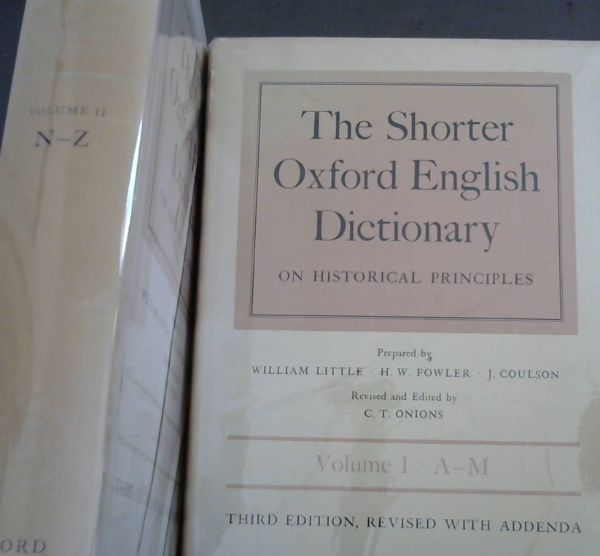It is called the New Shorter only because it is based, though not entirely, on the 21-volume Oxford English Dictionary (OED), which at £1,650 is beyond most people’s means.
- Now updated with more than 3,000 new words and meanings, the Shorter Oxford English Dictionary manages more than one third of the coverage of the OED in one-tenth the size. More than 500,000 definitions grace its 3,984 pages, and its innovative, open design makes this vast amount of information easily navigable and identifiable.
- Download Shorter Oxford English Dictionary 4.2 for Mac from our website for free. The actual developer of this software for Mac is WordWeb Software. The following versions: 1.4 and 1.1 are the most frequently downloaded ones by the program users.
- A fascinating and endlessly browsable reference, The New Shorter Oxford English Dictionaryprovides the definitive resource for scholars, professionals, general readers-for anyone, in fact, who wants the wealth of language available only in an unabridged dictionary.
- The Shorter Oxford English Dictionary contains an incredible one-third of the coverage of the 20-volume Oxford English Dictionary and includes all words in current English from 1700 to the present day, plus the vocabulary of Shakespeare, the Bible and other major works in English from before 1700.
Shorter Oxford English Dictionary
The Shorter Oxford English Dictionary (SOED) is a scaled-down version of the Oxford English Dictionary (OED). It comprises two volumes rather than the twenty needed for the full second edition of the OED. The sixth edition was published in August 2007.[1] Find me the app store.
An abridgement of the complete work was contemplated from 1879, when the Oxford University Press took over from the Philological Society on what was then known as A New English Dictionary on Historical Principles. However, no action was taken until 1902, when the work was begun by William Little, a fellow of Corpus Christi College, Oxford. He laboured until his death in 1922, at which point he had completed 'A' to 'T' and 'V'. The remaining letters were completed by H. W. Fowler ('U', 'X', 'Y', and 'Z') and Mrs. E. A. Coulson ('W') under the direction of Charles Talbut Onions, who succeeded Little as editor.
Onions wrote that SOED was 'to present in miniature all the features of the principal work' and to be 'a quintessence of those vast materials' in the complete OED.

The first edition was published in February 1933. It was reprinted in March and April of that year and again in 1934.
Macintosh 2016. A second edition appeared in 1936, and was reprinted in 1939.

A third edition was published in 1944, reprinted in 1947, 1950, 1952, and, with an addendum of new entries, in 1955. The third edition was published in America under the name The Oxford Universal Dictionary. A reset version of the third edition, with new addenda and with the etymologies revised by G. W. S. Friedrichsen, was published in 1973. This was also published in 1983 by Book Club Associates in the United States as the Shorter Oxford English Dictionary.

The whole text was completely revised for the fourth edition, which was published in 1993 as the New Shorter Oxford English Dictionary under the editorship of Lesley Brown. The book aims to include all English words which had substantial currency after 1700, plus the vocabulary of Shakespeare, John Milton, Edmund Spenser, and the 1611 Authorized Version of the Bible.[2] As a historical dictionary, it includes obsolete words if they are used by major authors and earlier meanings where they explain the development of a word. Mac os 10.5 8 download free. Headwords are traced back to their earliest usage.
The fifth edition was published in 2002,[3] and contains more than half a million definitions, with 83,500 illustrative quotations from 7,000 authors.
On September 21, 2007, 16,000 words lost their hyphens in a 6th edition of the Shorter Oxford English Dictionary.[3] Angus Stevenson, editor of the Shorter OED, stated the reason: 'People are not confident about using hyphens anymore, they're not really sure what they are for.' Its researchers reviewed 2 billion words (in newspapers, books, web sites and blogs from 2000). Bumble-bee is now bumblebee, ice-cream is ice cream and pot-belly is pot belly, etc.[4][5]
Electronic versions
The Shorter Oxford English Dictionary is available on CD-ROM for Windows and Macintosh.[6] Version 3.0 of that CD-ROM is copy-protected using SecuROM.

The dictionary is also available as an electronic download plug-in for WordWeb for Windows[7] and for Mac OS X.[8]
In addition to all of the contents of the traditional paper dictionary, the electronic versions include:
- Audio pronunciations
- Automatic look-up of words from other applications
- Search functions
- Crossword solver and anagram functions
References
- ^Oxford University Press, , Sixth EditionShorter Oxford English Dictionary
- ^Oxford University Press, The New Shorter Oxford English Dictionary, Fourth Edition, 1993, Preface
- ^ abOxford University Press, The New Shorter Oxford English Dictionary, Sixth Edition, 2007, Preface to the sixth edition
- ^'MSNBC, Hyphens perish as English marches on'. Archived from the original on 2009-10-09. Retrieved 2007-10-07.
- ^Reuters, Thousands of hyphens perish as English marches on (Retrieved 18 May 2008)
- ^Oxford University Press, 6th Edition on CD-ROMShorter Oxford English Dictionary
- ^WordWeb Software, Windows version Shorter Oxford English Dictionary
- ^WordWeb Software, Macintosh version Shorter Oxford English Dictionary
External links

- featuresSOEDDescription of PDF (142 KiB)
- Sample page from the dictionary PDF (128 KiB)
|
Shorter Oxford English Dictionary 1985
Help improve this article
Compiled by World Heritage Encyclopedia™ licensed under CC BY-SA 3.0Help to improve this article, make contributions at the Citational Source, sourced from Wikipedia
Shorter Oxford English Dictionary App
Shorter Oxford English Dictionary Pdf
